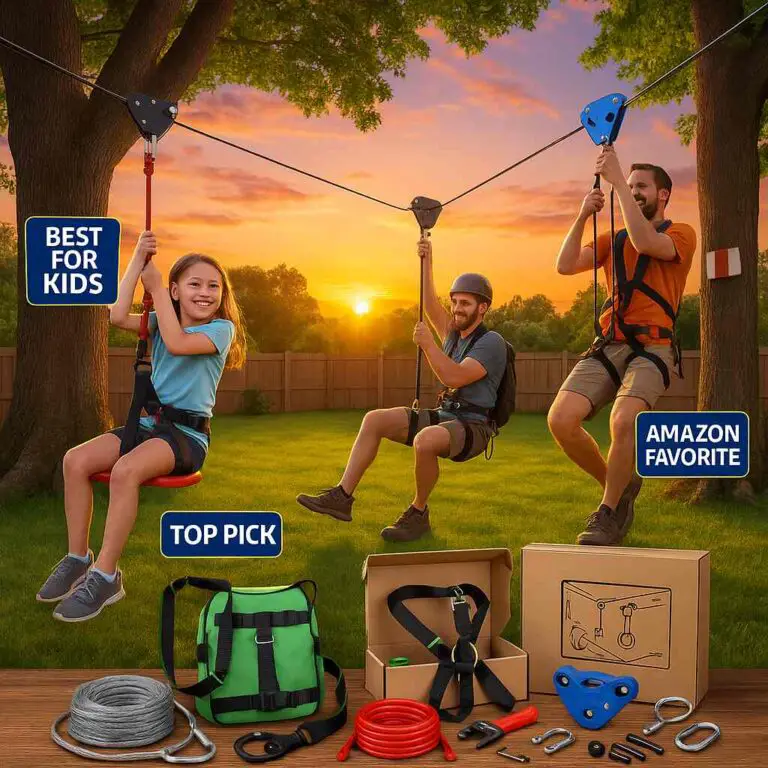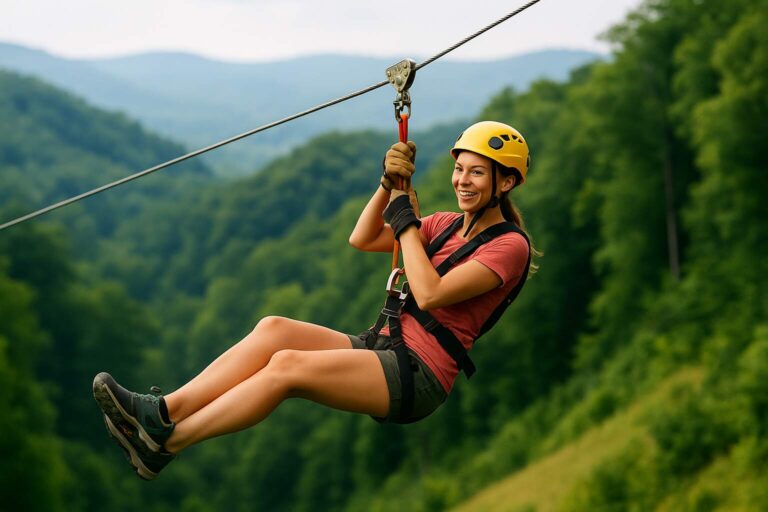Ziplining has become an increasingly popular outdoor adventure activity, offering a unique and exhilarating experience to thrill-seekers around the world. It involves riding a cable from an elevated point to a lower point while suspended by a harness, allowing the rider to fly through the air like a bird. However, while ziplining can be an exciting and unforgettable experience, there are also potential risks involved, including the possibility of getting stuck on the line.
If you get stuck on a zipline, it’s essential to remain calm and avoid panicking. You should signal for help using a whistle, horn, or shouting and use your safety equipment, including the harness and braking system, to stabilize yourself and avoid falling. It’s crucial to follow the zipline operator’s instructions and wait for assistance from the operator or rescue team.
In this post, I will explore what happens if you get stuck on a zipline in more detail, the possible scenarios that can occur, and the safety measures and equipment needed to stay safe while enjoying this thrilling activity.
How Ziplines Work
Before we delve into what happens if you get stuck on a zipline, it’s important to understand how zip lines work and the safety measures and equipment involved.
A zipline consists of a cable or rope stretched between two points, typically on an incline, with a pulley attached to a harness or seat that a rider sits or hangs on. Gravity propels the rider along the cable, with the speed controlled by the incline, tension, and weight of the rider.
Ziplines can be made of various materials, including steel cables, ropes, or synthetic fibers, and can vary in length and height. They can be set up in a variety of locations, such as forests, mountains, or even urban environments, depending on the desired experience and safety regulations.
To ensure safety while ziplining, several measures are taken, including the use of safety harnesses, helmets, and gloves. The rider’s harness is attached to the cable with a locking carabiner or other safety device, and a braking system is often installed at the end of the line to slow down and stop the rider’s momentum. Additionally, zipline operators should follow safety guidelines and regulations set by local authorities to ensure the safety of all riders.
Possible Scenarios of Getting Stuck on a Zipline
Despite the safety measures in place, there is still a possibility of getting stuck on a zipline. There are several scenarios that can lead to a rider getting stuck, including:
- Mechanical Failure: If the zipline equipment is not maintained or checked regularly, it may lead to mechanical failure. For instance, the pulley may get jammed, or the cable may snap, causing the rider to get stuck in mid-air.
- Rider Error: Inexperienced or reckless riders may make mistakes such as braking too soon or too late, leading to them getting stuck on the line. Riders who panic or fail to follow instructions may also become stuck.
- Environmental Factors: External factors such as strong winds, rain, or debris on the line may cause a rider to become stuck on the zipline.
- Obstacles on the Line: In some cases, a rider may collide with an obstacle such as a tree branch or bird that is on the line, causing them to become stuck.
- Medical Emergencies: A rider may become stuck on a zipline due to a medical emergency such as a heart attack or seizure.
In all of these scenarios, it’s essential to remain calm and follow the appropriate safety measures to ensure the rider’s safety.
Safety Measures for Getting Stuck on a Zipline
If you find yourself stuck on a zipline, there are several safety measures and steps you should take to ensure your safety:
- Remain Calm: It’s essential to stay calm and avoid panicking if you become stuck on a zipline. Panic can lead to further accidents or injuries, making the situation worse.
- Signal for Help: If you’re stuck on the line, call for help using a whistle, horn, or shouting. The zipline operator or other riders in your group should be able to hear you and alert the authorities.
- Follow the Operator’s Instructions: If the zipline operator is nearby, listen carefully to their instructions on what to do next. They may be able to assist you in getting unstuck.
- Use Your Safety Equipment: Use your safety equipment, including the harness and braking system, to stabilize yourself and avoid falling.
- Wait for Assistance: Avoid trying to get yourself unstuck if you’re not experienced in zipline safety or rescue techniques. Wait for assistance from the zipline operator or rescue team.
- Seek Medical Attention: Even if you’re not injured, seek medical attention after being stuck on a zipline. You may have experienced trauma or shock that may require attention.
Overall, following safety guidelines and instructions can help prevent getting stuck on a zipline, but if it does happen, remaining calm and following safety measures can help ensure a safe outcome.
Risks and Dangers of Ziplining
While ziplining can be a fun and exhilarating activity, there are inherent risks and dangers involved. These can include:
- Falls and Injuries: If a rider becomes detached from the zipline or the braking system fails, they may fall and suffer severe injuries or even death.
- Equipment Failure: As mentioned earlier, mechanical failure of the zipline equipment can lead to accidents and injuries.
- Weather Conditions: Weather conditions such as heavy rain, strong winds, or lightning can pose a significant danger to riders, leading to accidents or injuries.
- Collisions: Riders may collide with obstacles such as trees, rocks, or other riders on the line, causing injuries.
- Health Conditions: Riders with underlying health conditions such as heart problems or high blood pressure may experience medical emergencies while ziplining.
To minimize the risks and dangers of ziplining, it’s essential to follow safety guidelines and regulations, wear appropriate safety equipment, and avoid taking unnecessary risks. Additionally, riders should ensure they are physically fit and do not have any underlying health conditions that may pose a danger while ziplining.
While ziplining can be a thrilling and exciting experience, it’s essential to understand and mitigate the inherent risks and dangers involved to ensure a safe and enjoyable adventure.
Conclusion
In conclusion, ziplining is a popular outdoor adventure activity that provides a unique and exhilarating experience to thrill-seekers worldwide. While the activity is generally safe when proper safety measures and guidelines are followed, there are potential risks and dangers involved, including getting stuck on the zipline.
If you find yourself stuck on a zipline, it’s crucial to remain calm, follow the operator’s instructions, and use your safety equipment to ensure your safety. Additionally, riders should be aware of the risks and dangers of ziplining, including falls, equipment failure, weather conditions, collisions, and health conditions.
By taking the necessary precautions, including wearing appropriate safety equipment, following safety guidelines, and avoiding unnecessary risks, riders can enjoy the thrill and excitement of ziplining safely. Ultimately, the experience of ziplining can be unforgettable, and riders can make the most of it by prioritizing their safety and well-being.








